Workplace incidents are traumatic and stressful events. The workers involved often are panicked, scared, and don't know what to do.
Your goal is to really drill down and find out why the incident happened so that useful corrective actions can be put in place to avoid recurrence. To do this, you have to look beyond the obvious!
How do you make sure, that in this situation, you can gather the information you will need?
Complete A Detailed Root Cause Investigation
To complete a detailed root cause investigation, you need to be ready. Here this is the key to being “ready”: Work backward from the causes to the scene… Not the other way ... things get missed when you work from scene to cause.
KNOW YOUR FIVE CATEGORIES! Keep them in mind as you move through the workplace investigation framework. Ask questions and look for evidence of these five categories in each step. Make detailed notes pertaining to the root causes, as you go.
- Task
- Material
- Work Environment
- Personnel
- Management
Take advantage of our Free Download - Workplace Investigation Toolkit and Guide to help you successfully move through a Workplace Incident Investigation.
I Want The Free Incident & Investigation Guide!
Task - Look at the work procedure being used at the time of the workplace incident.
- Was it safe?
- Had the worksite or conditions changed to make the usual process unsafe?
- Were appropriate tools and materials available and being used?
- Were safety guards and devices used properly?
- Was a lockout used? Should it have been?
Follow up on these questions with “if not, why not?”
Material - Equipment and materials
- Was there an equipment failure?
- What was the cause?
- Were materials or equipment substandard?
- Were hazardous products used and if so were they identified clearly?
- Could a less hazardous alternative be used?
- PPE -Should it have been used? Were the workers trained to use it properly?
Follow up by asking WHY these situations were allowed to exist?
Work Environment - Look at all aspects of the work environment and sudden changes that may have compromised an initially safe environment. Make sure the “real-time” situation is what is documented. Consider these factors:
- Weather - any unusual conditions as well as heat and cold environments
- Housekeeping
- Noise
- Lighting
- Toxic or hazardous gases, dust or fumes
Personnel - Explore the physical and mental state of the workers involved. Remember to consider the psychological environment as well. These can change from day to day and are often influenced by external sources.
- Were the workers fatigued?
- Did they have sufficient training and/or experience?
- Was shiftwork an issue?
- How about stress - at work or personal?
- Was there pressure to complete the task or to bypass safety procedures?
Management - With the legal obligation for the safety of the workplace, the role of management and a management system must be considered when investigating a workplace incident. Management system failures can factor directly or indirectly in the cause of the incident.
- Were safety rules and procedures clearly and successfully communicated to workers?
- Did workers have access to safe work procedures and were these procedures being enforced?
- How about training? Was it consistent and adequate?
- Were safety inspections regularly conducted and are unsafe conditions corrected?
- Had there been previous concerns raised about the condition that lead to the incident? Had actions been taken?
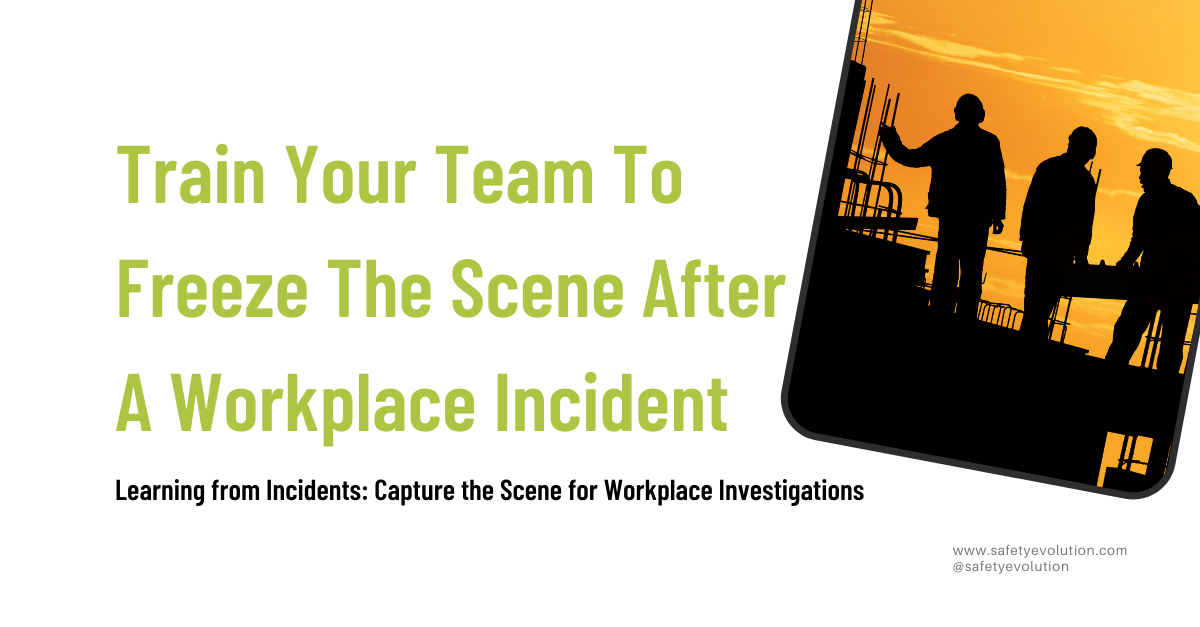
Train Your Team To Freeze The Scene After A Workplace Incident
Once the emergency response team has ensured that the injured are given the necessary first aid/ medical attention, that all workers are accounted for, and that there is no ongoing danger at the scene, the important second step is to FREEZE the scene. In other words, keep everything intact. Preserve the scene as it was at the time of the incident.
Start with a larger area which can be reduced as all the facts come to light. Taping off or barricading contains the area and keeps those not involved in the investigation from entering the area.
Document the weather at the time of the incident. Will the weather compromise the integrity of the scene? Could wind or rain impact important evidence? Do you need to cover any part of the scene with tarps or other protection?
What about traffic? Is your scene in a high vehicle traffic area? Can traffic be re-routed and if not, now will you ensure that evidence is not picked up by vehicle tires?
Screening a scene should always be considered where there is pedestrian traffic Do pedestrians need to be protected from the sights of the incident … does your worksite need to be protected from unwanted social media posts from passers-by?
Take your time and don’t allow the sights, sounds, and smells at the scene to overwhelm you! Take things slowly and remember your five categories as you “Freeze” the scene.
Draw on resources available. You don’t have to do this all yourself!
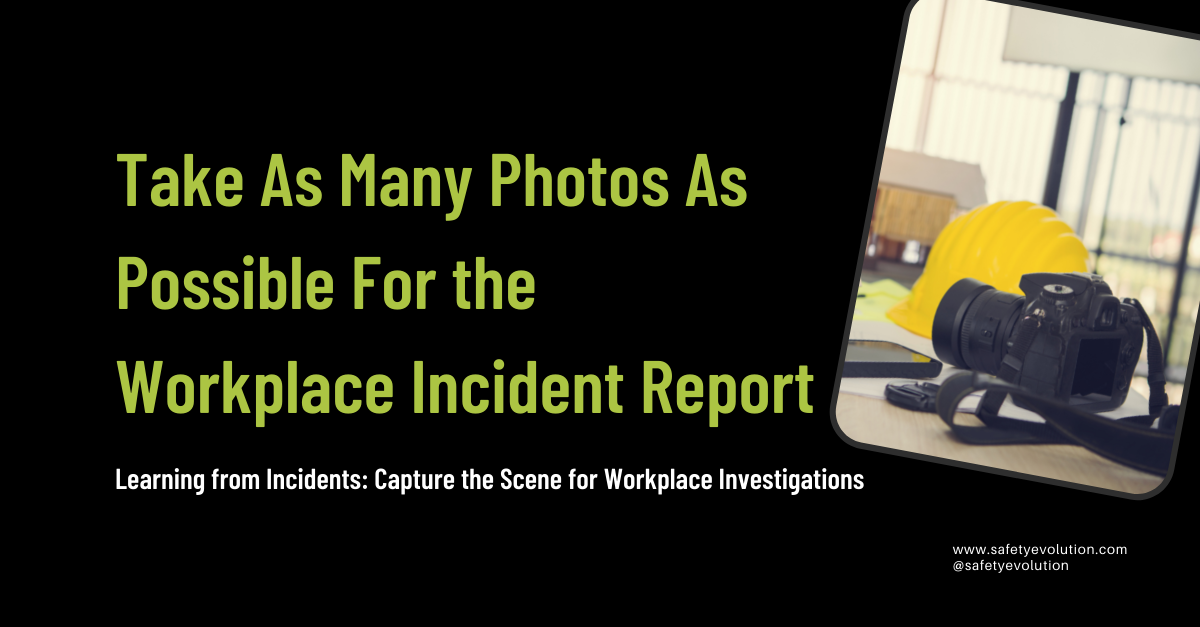
Take As Many Photos As Possible For the Workplace Incident Report
Remember your five basic causes when you are taking photos!
Your immediate focus will be to capture the injury or the damage accurately, but also look for opportunities to take photos at the scene that relate to as many causes as possible.
Start taking the photos on the perimeter of the incident scene and work inward. Take photos from every angle. Include photos that will answer some of the questions you need to ask to dig down to the cause.
You can never have TOO many photos! They are so important to your investigation. Photos are a way of preserving the two things that are most easily lost after an incident…. Evidence and memory! Use your photos as you gather witness statements. Photos are great “memory joggers”
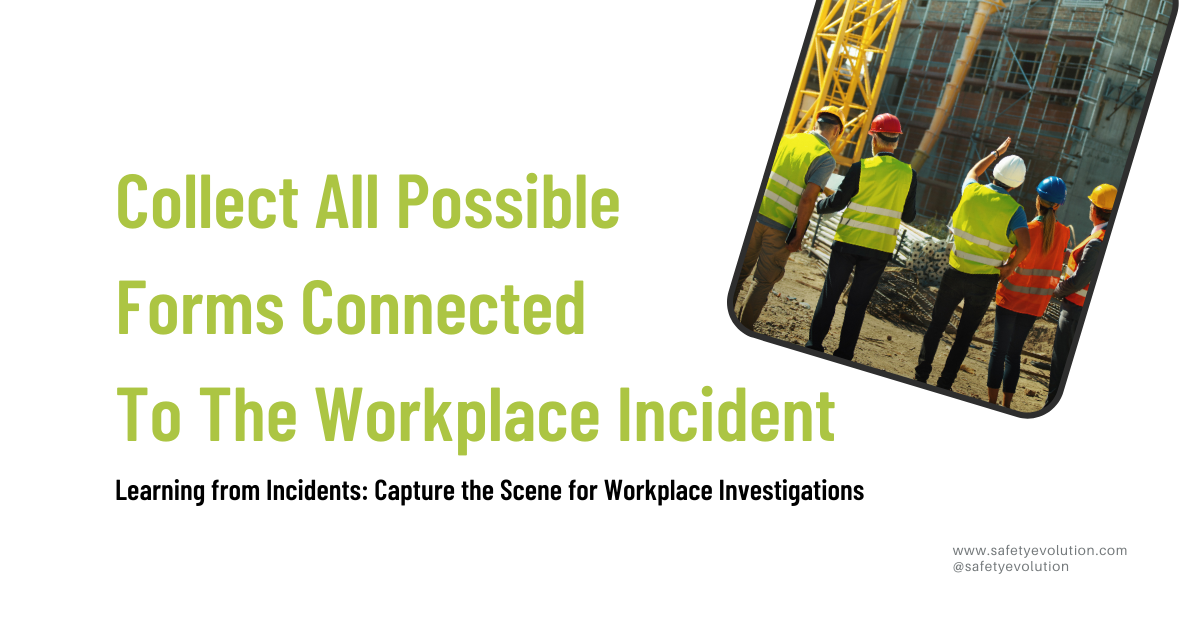
Collect All Possible Paperwork & Forms Connected To The Workplace Incident
The supporting paperwork that becomes part of an incident investigation may vary from one company to another. We have put together a basic list and some questions to get you started.
- Field Level Hazard Assessment / FLHA - Was the worker(s) involved in the incident aware of the hazard on the site? Were they part of identifying hazards prior to starting the workday?
- Toolbox or Safety Meeting - Was the worker(s) involved in the most recent safety meeting? Was the safety meeting content relevant to the workplace incident?
- Inspections - Site and equipment inspections as well as the corrective actions that may have been created from these.
- Permits - All permits applicable to the incident site ( work permits, hot work permits, confined space permits, etc.)
You may also need to look into:
- Training and Orientation - Did they have recent training that is relevant to the incident? How long ago did they train? Should retraining be a corrective action? Are they new or young workers? When did they do orientation? Who is their mentor?
- Safe Work Procedures – Is there a documented procedure in place that is relevant to the incident?
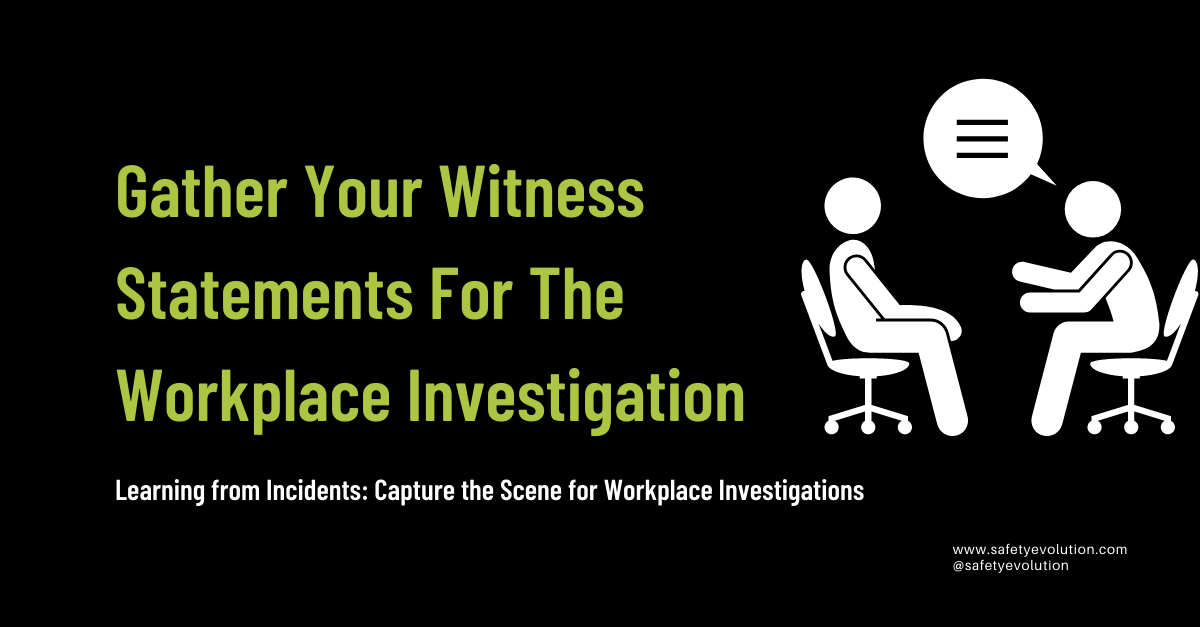
Gather Your Witness Statements For The Workplace Investigation
It is vital that any worker involved in an incident knows the reason that incidents are investigated. Reaffirm workplace investigations are not “fault-finding” missions. The only goal is to gather as much information as possible to prevent the incident from recurring.
What category of the causal model will you incorporate into the information you will gather from witnesses? Task, Work Environment, Personnel?
Asking the right questions of witnesses will help you “capture the scene” with first-hand knowledge from those who were there. Getting really detailed information sooner rather than later is so important. Were there others at the scene like visitors or members of the general public whose statements could shed light on the incident?
Not everyone on the job site will be able to put their full recollections into a written statement. You may need to draw out the information by asking questions and showing photos of the scene. Make sure the witnesses feel safe and that they understand the value of their responses.
Please take advantage of our FREE downloadable Workplace Investigation toolkit and guide to help you successfully move through an Incident Investigation.

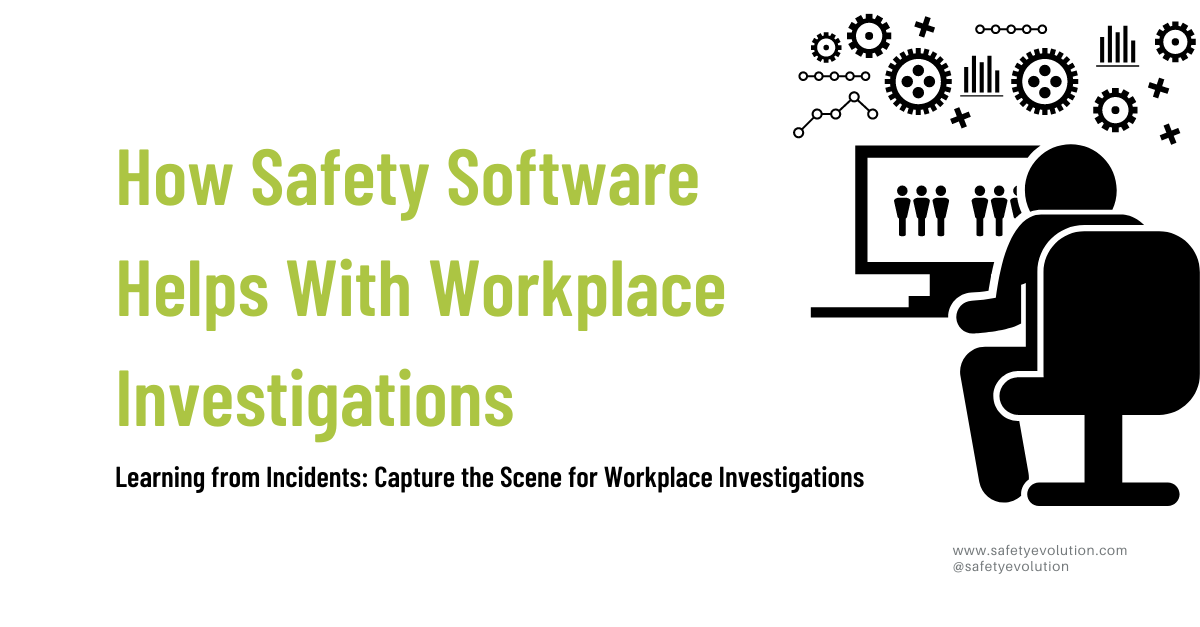
How Safety Software Helps with Workplace Investigations
David mentioned in the video that, as a result of numerous investigations, Safety Evolution has built an Investigation process that gathers all the necessary information seamlessly.
No more pulling documents and endless photocopying. No more tracking down witness statements.
Our Investigation module starts with a simple “click” which opens the initial incident report and puts the Investigation and Corrective Action workflow in motion.
Here’s how it works:
- The initial report is formatted to capture the details of the incident, the names, and statements of witnesses, and all of the photos from the scene. All the little details that can be missed are addressed. Once this information is gathered at the scene, the content is automatically sent to the designated individual who will be conducting the workplace investigation.
- The software gathers the relevant documentation for the forms stored in the database and attaches them to the workplace investigation.
- The investigator can easily access all the causal factors and create corrective actions
- The corrective actions are assigned and tracked by the software… no more lists and spreadsheets!
- The software alerts management that a workplace incident has occurred on a company worksite.
Taking your company “paperless” and into a safety software like Safety Evolution eases the “pain points” of Safety. Less admin work, more site time to build your safety culture! Check out our Demo On Demand to see how!

Sign up to receive our weekly newsletter with helpful safety content below!